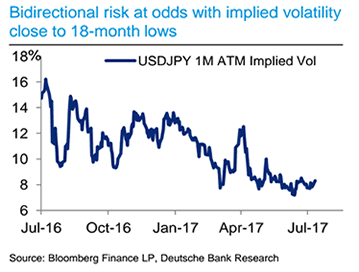D.B. Warn 5%+ Decline Ahead for GBP/EUR Exchange Rate
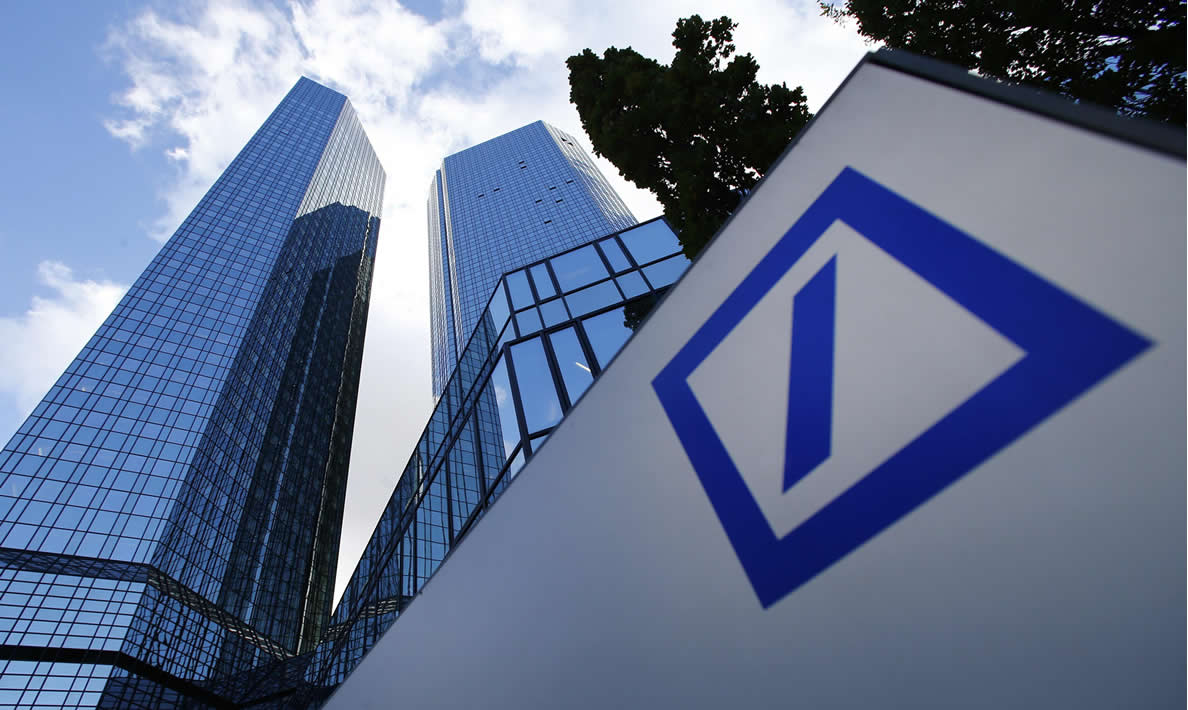
“We are more positive on the Euro, with upside to the Dollar and Sterling” - Deutsche Bank in their July 'house view' update.
Deutsche Bank AG have warned Pound Sterling could devalue by a further 5% from current levels against the Euro.
Briefing investors on their latest ‘house views’ on global markets they say they have upgraded their view on the Euro in light of its continued outperformance which has seen the single currency emerge as the dominant force in global currency markets.
This translates into a bearish stance on GBP/EUR and echoes similar upgrades to the single currency made at other research institutions.
Other themes include Deutsche Bank calling a top in the US Dollar but also warning that it would be premature to anticipate a sharp downward correction in the Greenback.
Elsewhere, the Japanese yen is at risk of weakening.
Euro at 1.20 vs US Dollar by 2018
The Euro is likely to enjoy further strength against the Dollar and a summary of Deutsche Bank's views on EUR/USD are as follows:
- We turned more positive on Euro
- Currency has since broken the top of 2.5-year 1.05-1.15 range
- Short-end rate differentials now less of a driver for EUR/USD rate
- Macron brings political upside to currency, i.e., France / Germany policy initiatives, fiscal stimulus
- Real money underweight euro
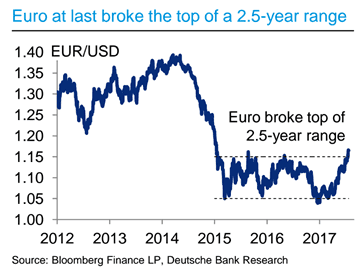
Bearish Sterling versus Euro
As you can see, the central theme for analysts at the German investment bank is a stronger Euro going forward.
Add to this soft sentiment towards Sterling, and we get a GBP/EUR cross that is likely to go lower. Analysts argue:
- Limit to Sterling downside vs. Dollar as BoE uncomfortable with weak Pound
- But currency uniquely exposed to earlier / faster ECB tightening − G10’s largest current account deficit, lowest real rates
- By end-2018 see Sterling down 5%+ vs. Euro, but only around 3% vs. dollar
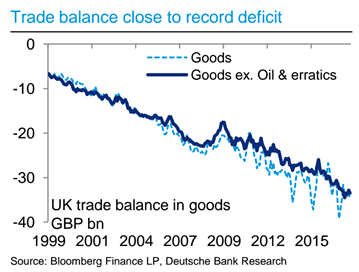
So it’s full steam ahead for the single currency it would appear.
Of late we have noted a number of analysts upgrade their forecasts for the Euro with HSBC saying they see EUR/USD striking 1.20 by the end of 2017 and EUR/GBP racing towards parity.
If HSBC are right, this will put a massive strain on those who import from Europe, so I would suggest you get cracking with securing your hedges.
We do note a good amount of year-end forecasts for EUR/GBP do however reside in the 1.11 area where strong support lies and for now we would not be panicked by the 1.0 forecast, yet.
Viraj Patel at ING Bank N.V says that while GBP/USD sub-1.30 seems about right, EUR/GBP looks set for a near-term test of the psychologically important 0.90 level.
“Risks are that we stay above there,” says the analyst.
EUR/GBP at 0.90 equals a Pound to Euro exchange rate at 1.11.
Analysts at JP Morgan have this month upgraded their forecasts for the Euro exchange rate complex and see now see EUR/USD rising to 1.15 (Q3), which is more in line with previous medium term forecast.
They have also raised their 2017 Q4 forecast to 1.16.
In Q1 2018 they expect the pair to hit 1.15 and then 1.18 in June.
The EUR/GBP exchange rate is seen rising to 0.89 by the end of the third-quarter and to 0.90 by the end of 2017, up from 0.8783 currently.
This is a Pound to Euro exchange rate of 1.1236 and 1.1111.
Get up to 5% more foreign exchange by using a specialist provider. Get closer to the real market rate and avoid the gaping spreads charged by your bank for international payments. Learn more here.
US Dollar has Formed a Top
The US Dollar has weakened by 10% this year – and Deutsche Bank say they see there are signs of a dollar ‘top’ forming in this mature bull cycle (typically 6-7 years).
In previous dollar tops (1985, 2002) the currency’s initial downward slide was sharp.
However, analysts argue conditions are not in place for a sharp Dollar devaluation this time around, at least not yet.
Why?
- Dollar tops are typically signalled by valuation extremes, but dollar hasn’t exceeded +20% overvaluation band
- US current account is stable, owing to better energy balances – whereas generally it worsens by 1.5pp of GDP in the 2 years before a peak
- Dollar interest rates are typically falling on G10 ranking tables in a dollar downcycle
- this is not the case at the moment
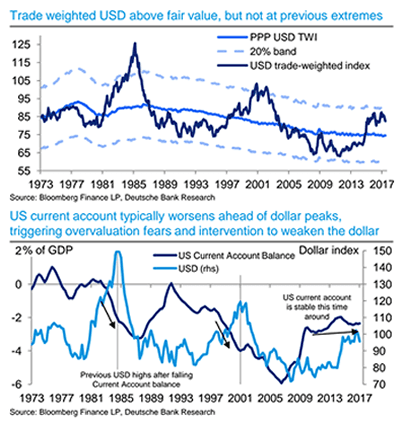
Bi-directional risks to USDJPY
With BoJ on hold, Fed tightening, Deutsche Bank say they see a weaker yen with USDJPY up to 120 by end-2018
- But risks are high on both sides
- Weaker yen if US inflation rises and Fed tightens faster
- Stronger yen if Japan policy continuity is seen at risk
- Bidirectional risks mean implied USDJPY volatility is too low
